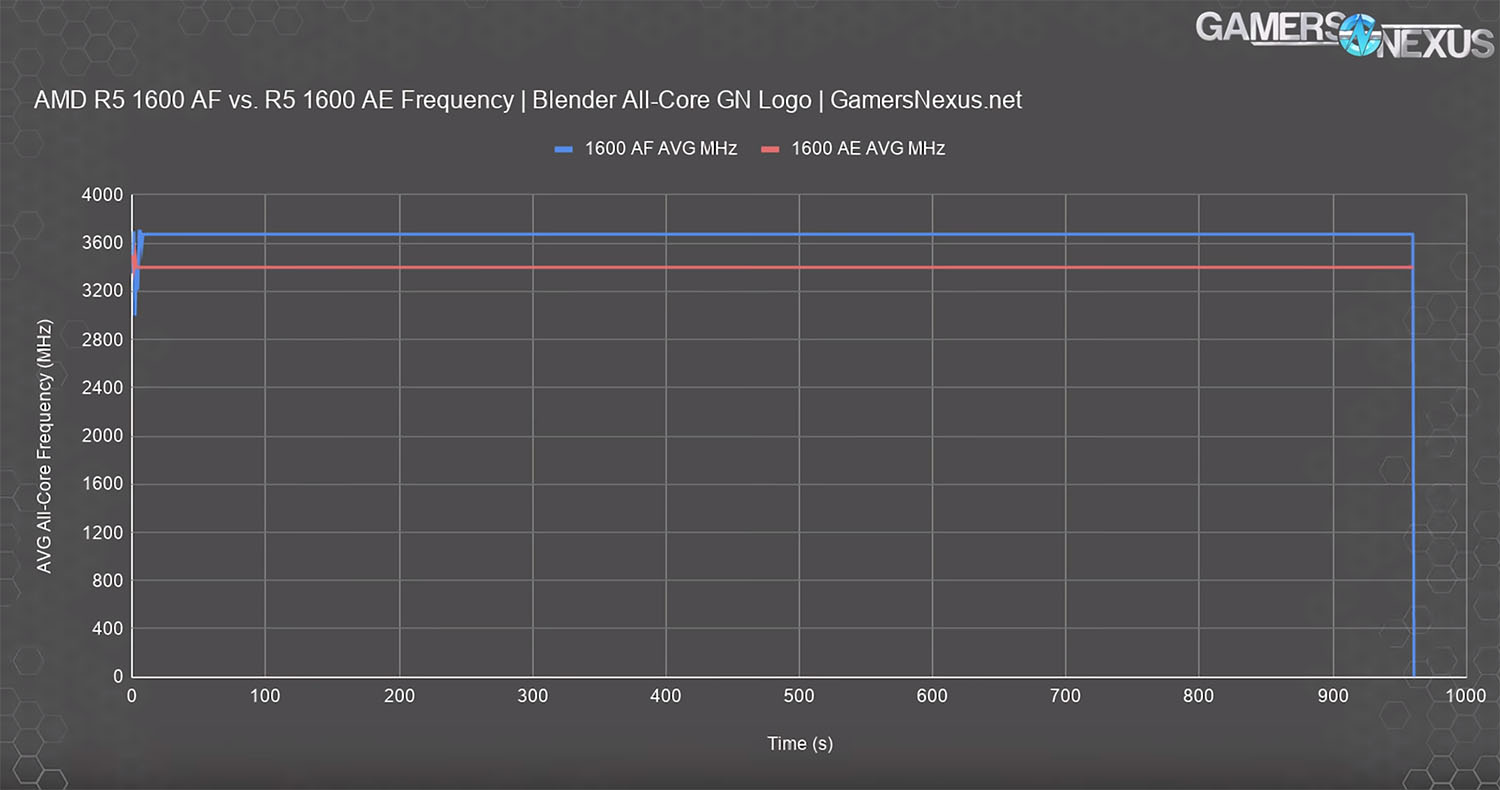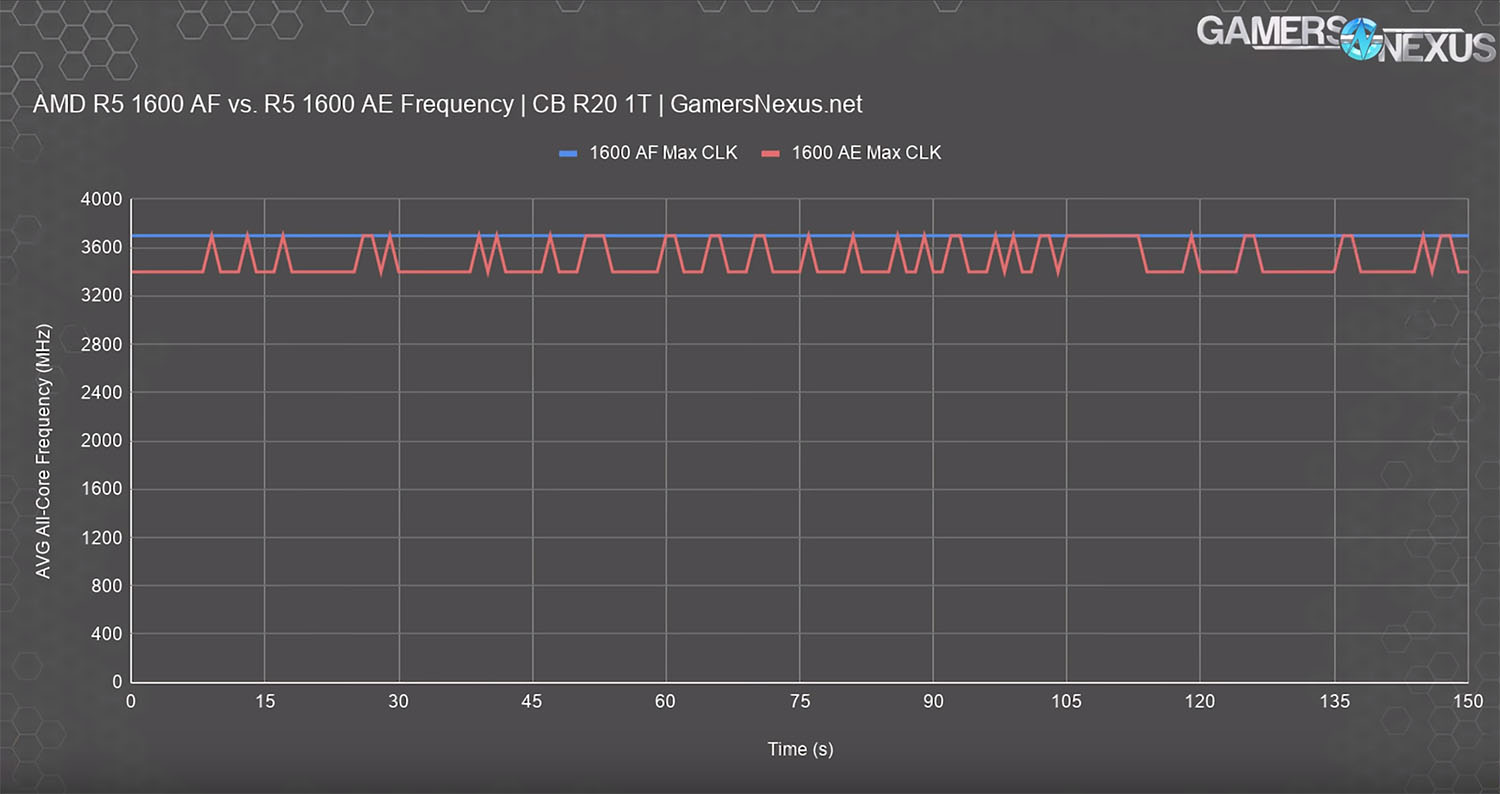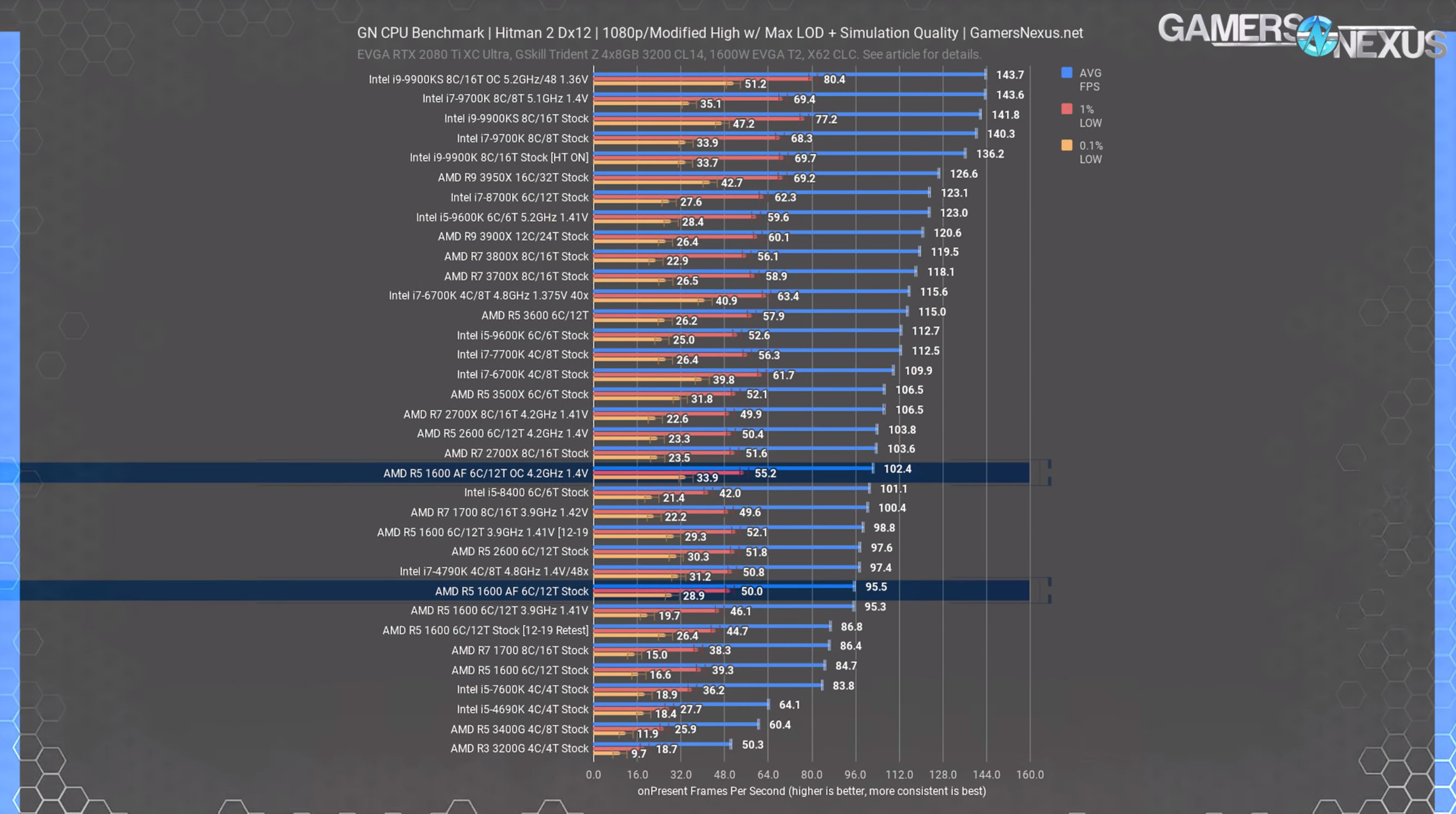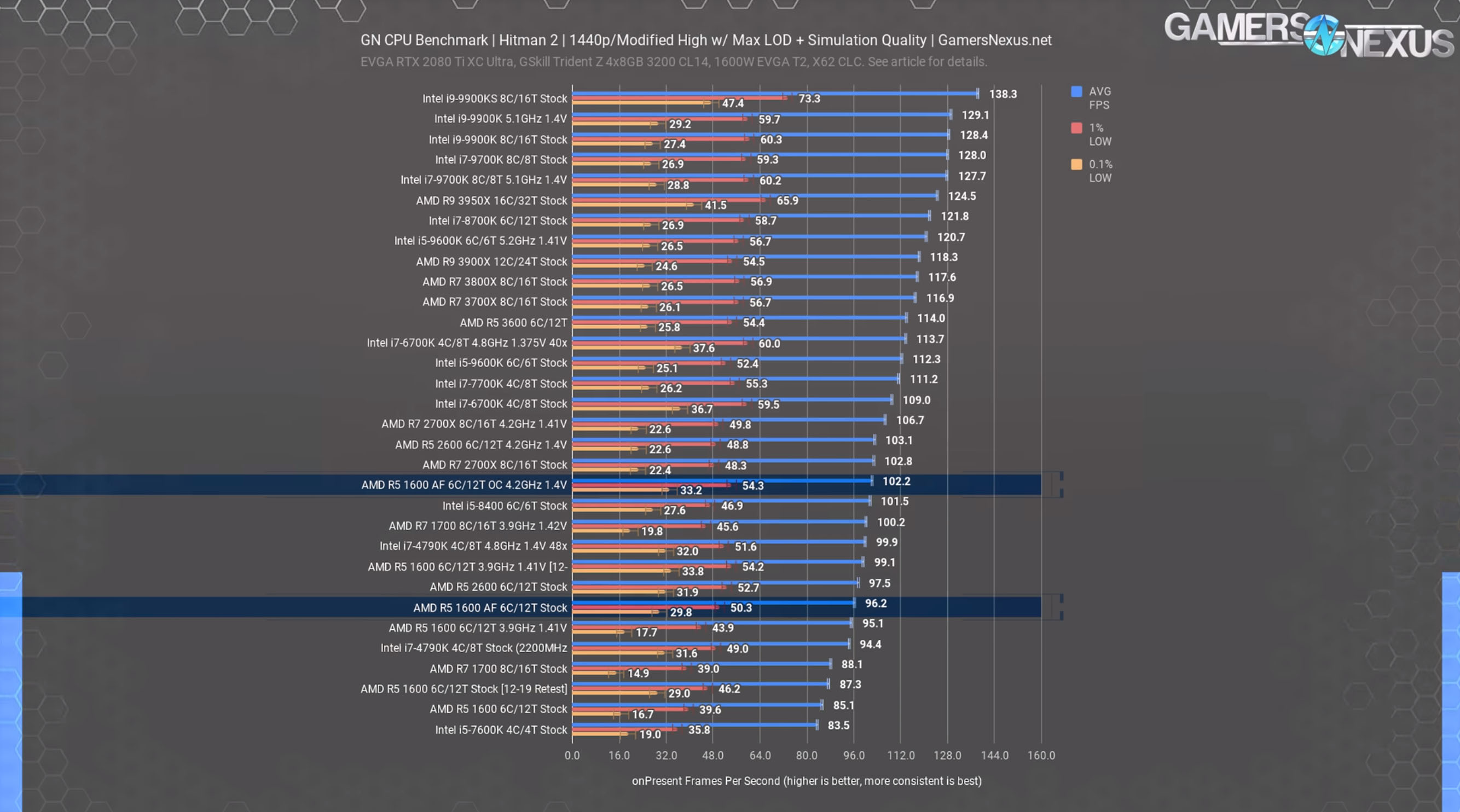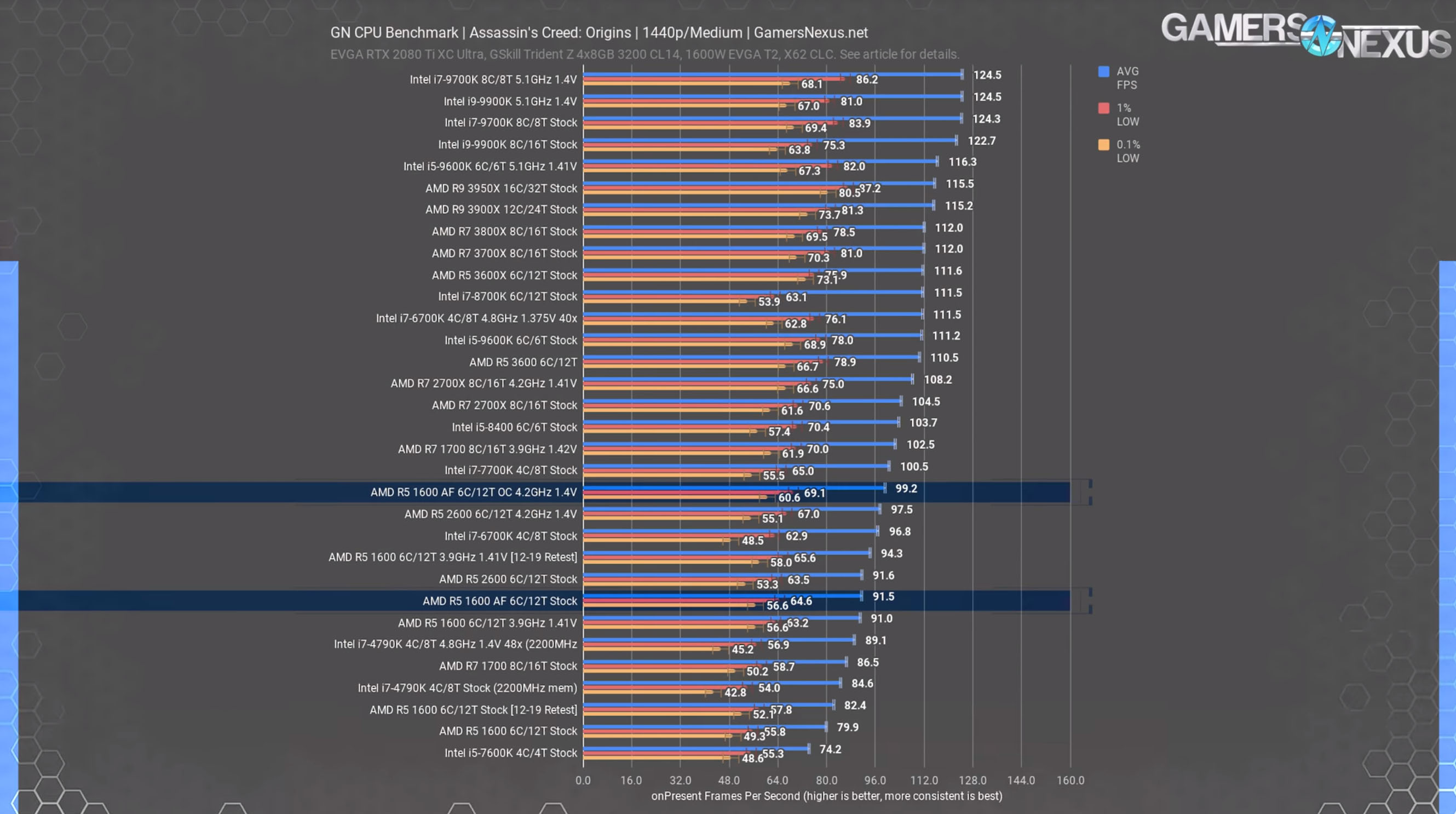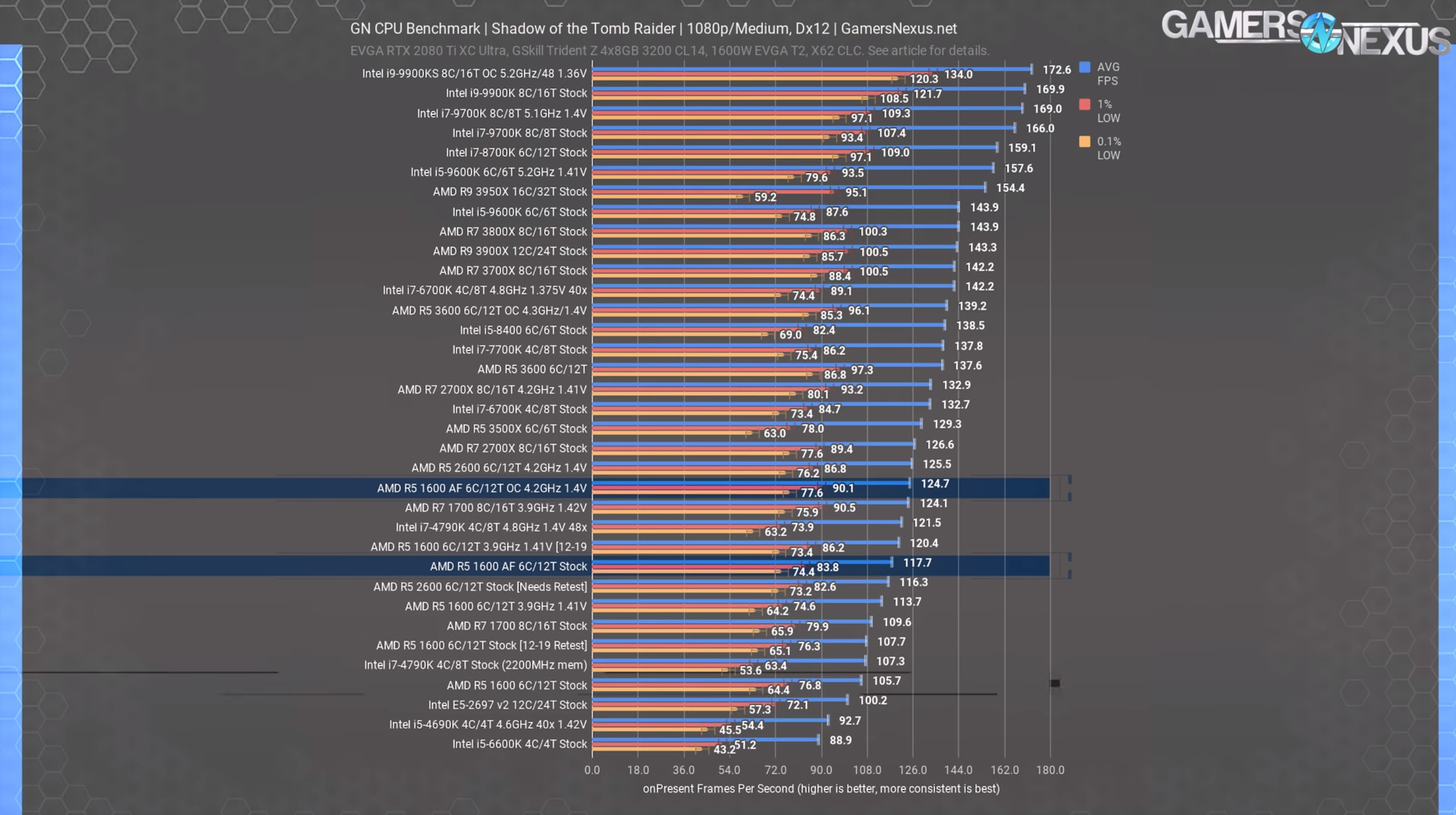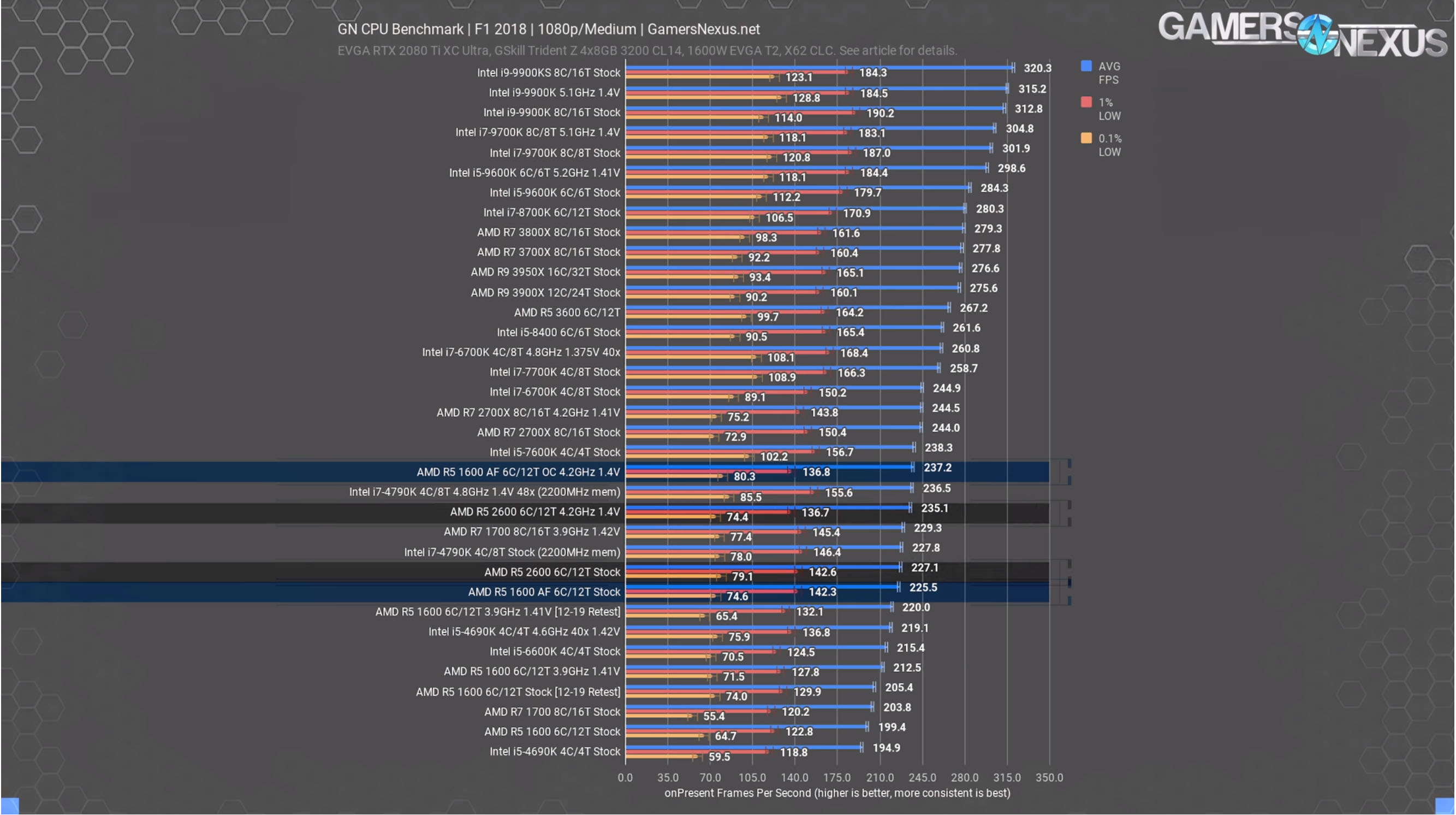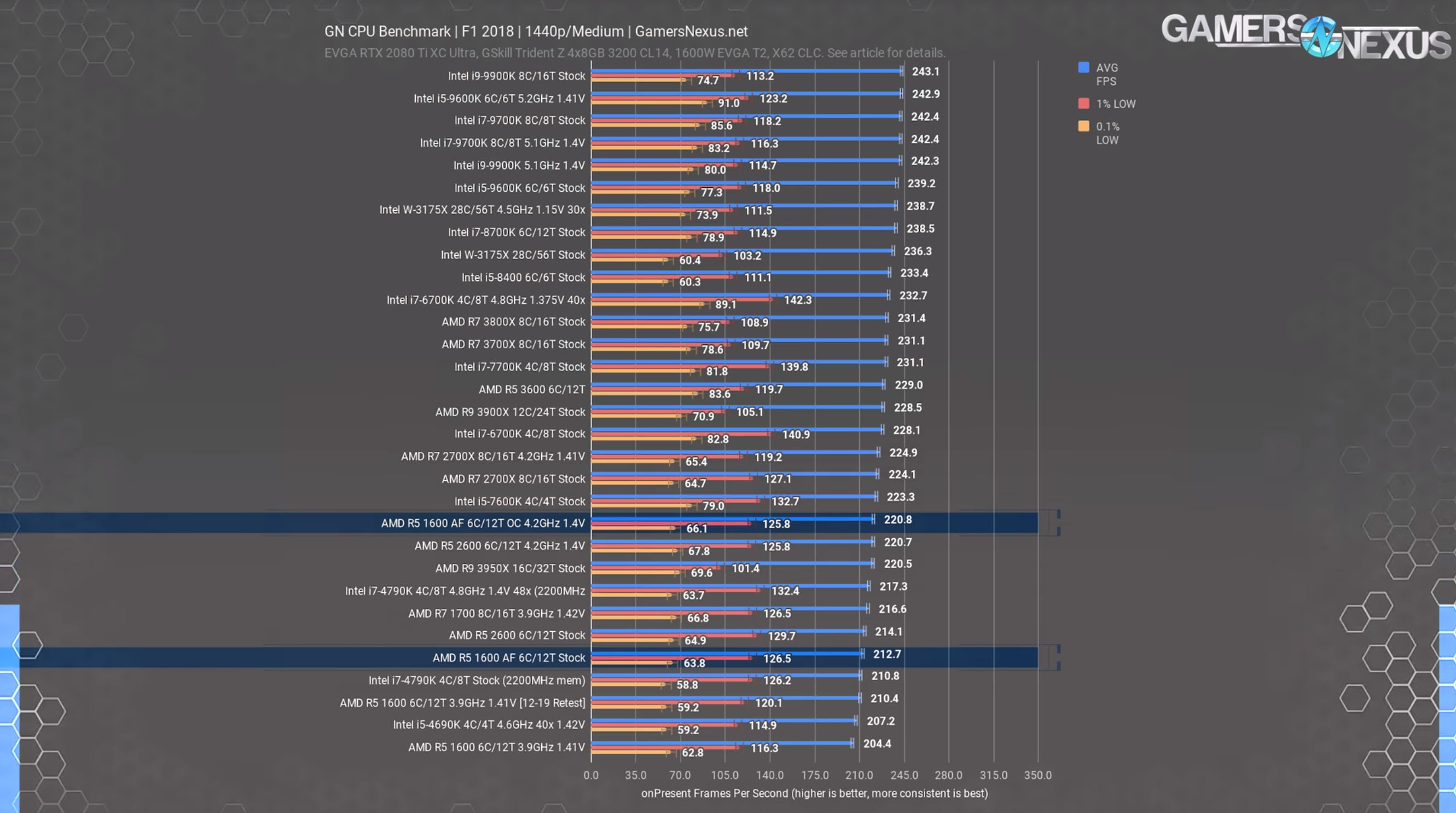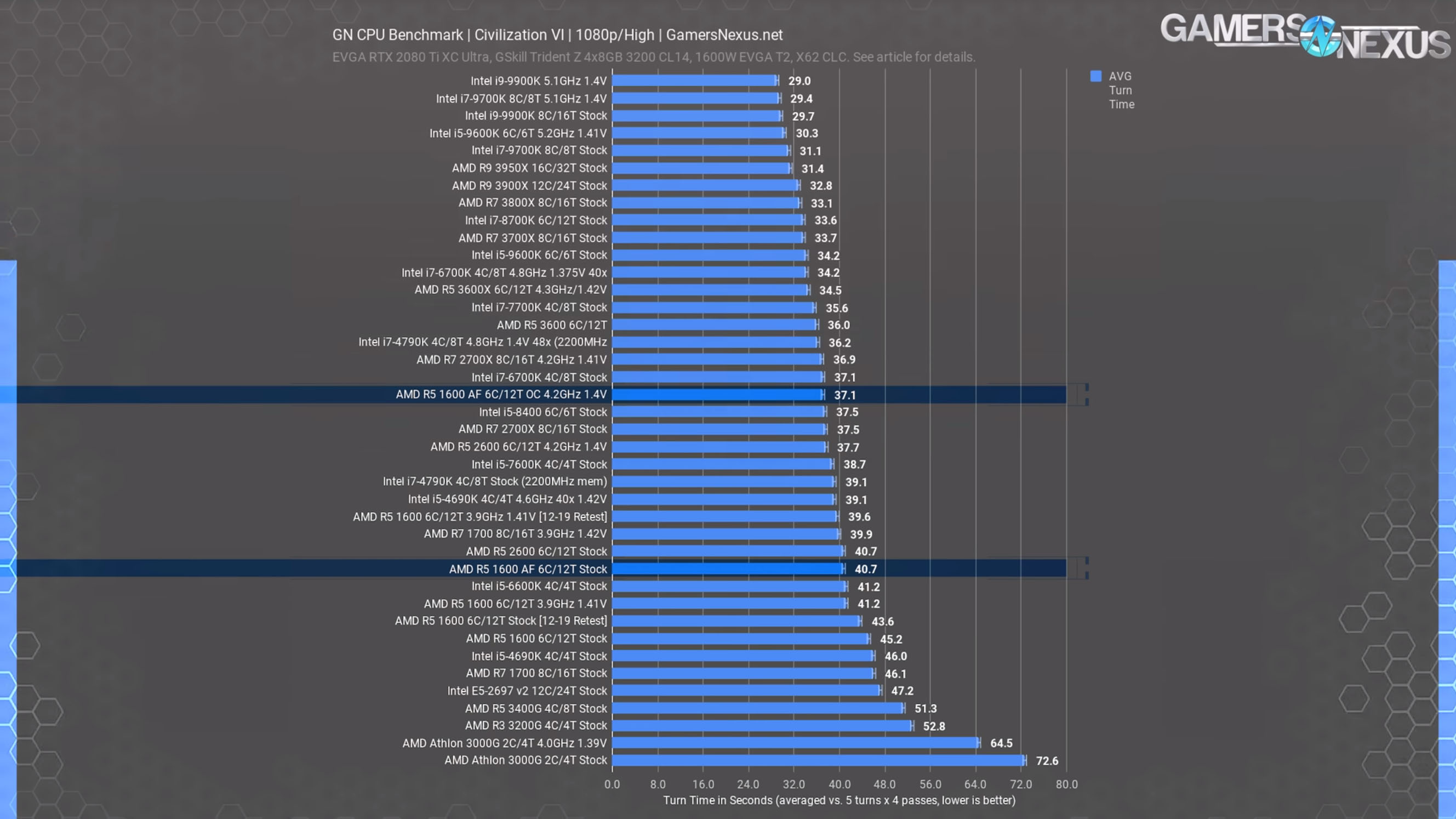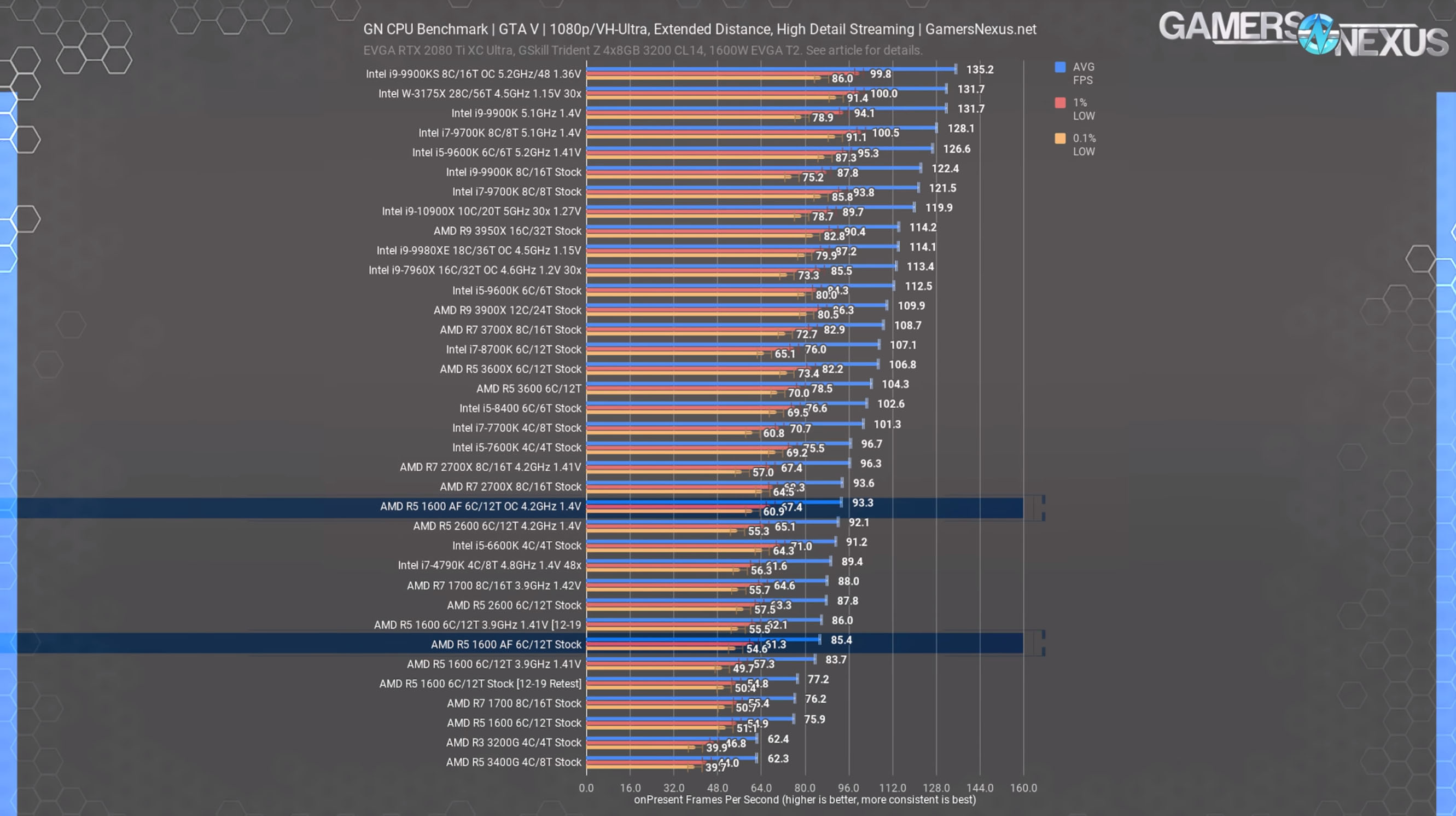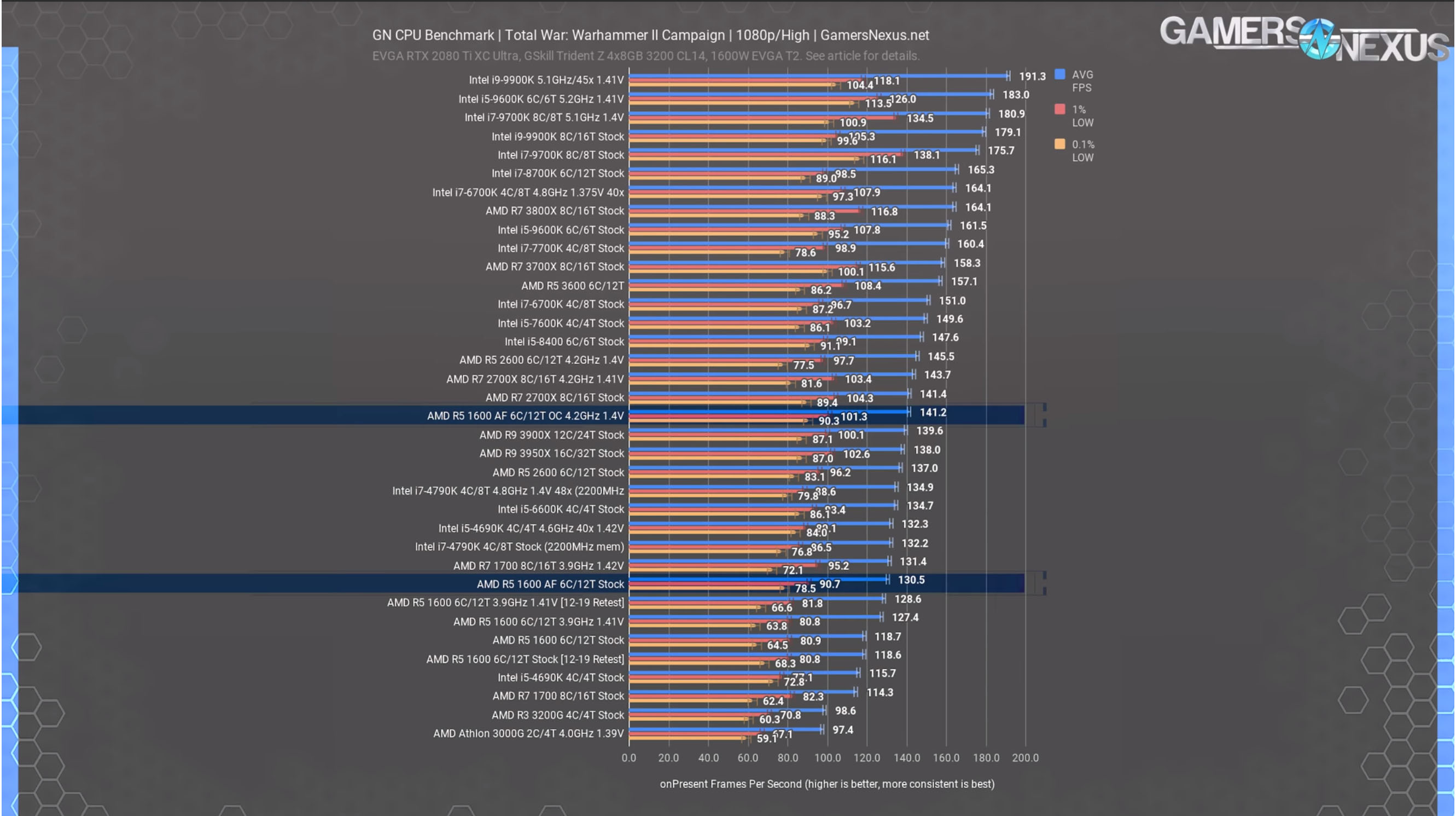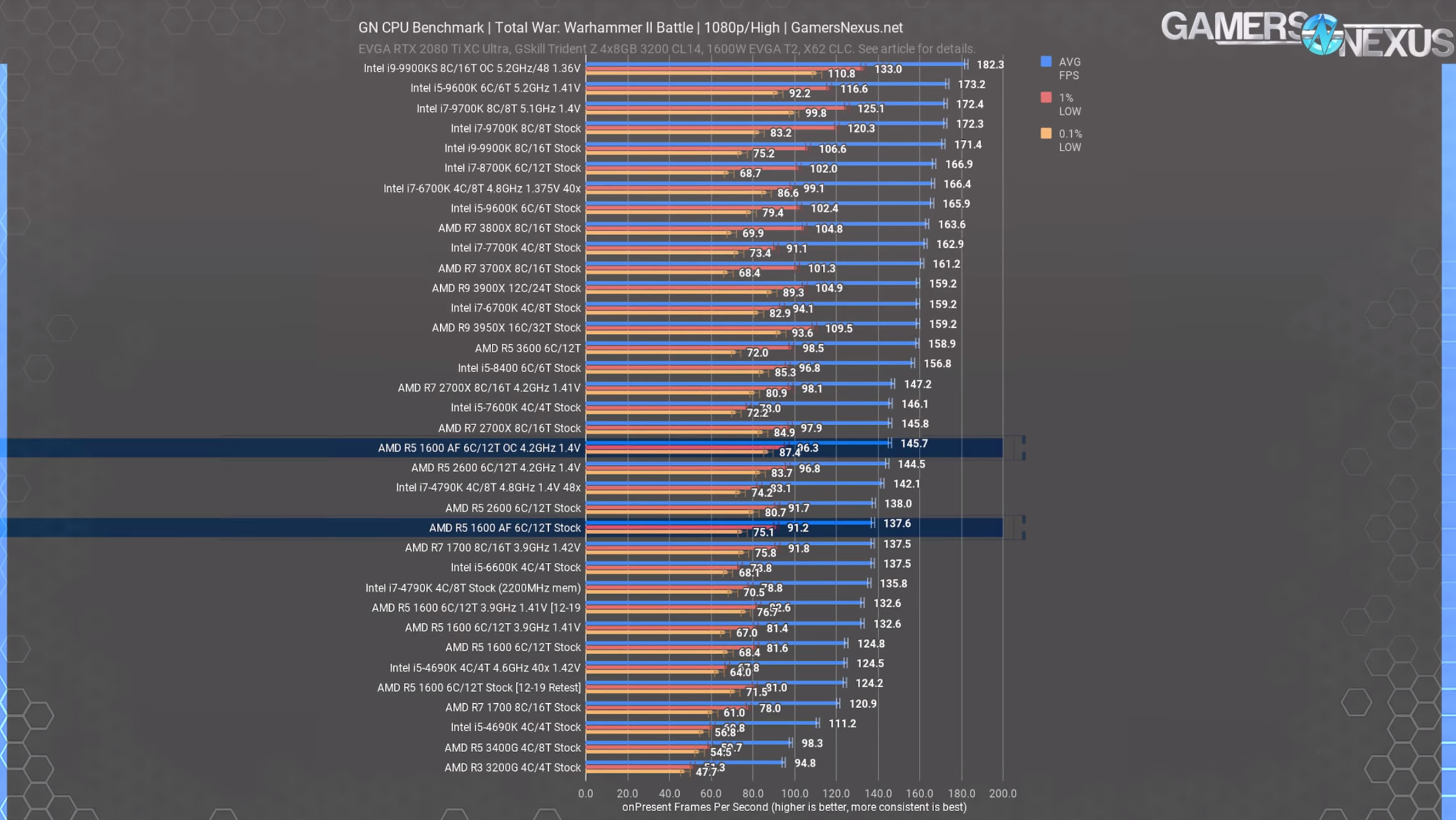This isn’t a revisit of the old AMD Ryzen 5 1600 – it’s a review of the new variant, named the AMD Ryzen 5 1600 “AF” by the community, dubbed as such for its SKU change from AE to AF. The AMD R5 1600 AF is a brand new CPU with an old, old name from 2017. It’s mostly an R5 2600, in that it’s a slower variant of the Zen+ CPU from the 2000-series, but with a 1000-series name. AMD silently released the 1600 AF as an $85 option, but it’s on 12nm instead of 14nm and carries other 2nd-Gen Ryzen features. In today’s review of the new $85 processor, we’ll look at performance versus the original R5 1600, the R5 2600, and overclocking performance, since a 12nm 1600 AF should do about the same OC as a 12nm Ryzen 2000 part, which were typically 100-200MHz higher than the 1000-series.
The R5 1600 AF is a weird, weird refresh. It’s mostly odd that AMD didn’t just name it Ryzen 3 3300X or Ryzen 5 3550. They already have the 3000 family with Zen+ architecture and the 3000G with Zen1 architecture, so it wouldn’t dilute the naming and it’d be a much more successful, higher selling product with a lot of media fanfare. Instead, it just sounds like a two-year-old part, but it’s really not. We can’t fault AMD for its naming and it doesn’t particularly bother us, it’s just a bit odd from a marketing standpoint. Maybe AMD doesn’t want to sell a lot of these.
AMD told us that the new Ryzen 5 1600 AF is a 2nd-gen replacement for the 1st-gen part, as AMD no longer has inventory of its 14nm wafer supply, and so has shifted it instead to the newer 12nm supply that it still has. This is also interesting because it indicates AMD is still making some of these parts, and may have still been making 14nm R5 1600 parts.
AMD noted to us that the switch to include the smaller Wraith Stealth cooler is the trade-off and part of the cost savings, but also elaborated that the 1600 replacement on 12nm is more efficient and includes the same cooler as the R5 2600’s stock cooler. Since it worked for the 2600, which is the same other than higher stock speeds, it will also work for the R5 1600 in the same way.
Unofficially, the 2600 might be binned better than the 1600 AF, but there’s no guarantee or formal confirmation of that. Our retail-purchased R5 1600 AF clocked the same as our R5 2600, for what it’s worth, although that’s hardly any sample size worthy of consideration.
Overclocking Results
Overclocking more or less confirms what we were told by AMD, which is that the 1600 AF is on 2nd-gen Ryzen, or Zen+ architecture, as we were able to hit 4.2GHz at 1.4V on the 1600 AF. For reference, we were never able to get our 1000-series Ryzen CPUs above 4.0GHz in almost any circumstance with normal cooling. They hit a hard wall at 4.0GHz. Our original 1600 “AE” could only do 3.9GHz.
Frequency Benchmarks
We should start with a frequency chart before wasting our time on testing. It wouldn’t make sense to re-do all the testing if the frequencies are identical.
First, looking at an all-core workload from Blender and the GN Logo render, we monitored the AMD R5 1600 AF CPU AVG all-core frequency at 3674MHz flat. There’s no fluctuation here because, unlike Zen2, Precision Boost 2 isn’t working to wildly fluctuate the clock based on every few degrees of change in the die temperature. The AMD R5 1600 AE -- that’s the older one -- plotted at 3399MHz all-core average. There’s a marked gain from the 1600 AF just in the all-core frequency, and clearly the AF should actually be better than the AE.
Cinebench R20 1T Frequency Comparison
For Cinebench R20 with a single-thread load, we measured the AMD R5 1600 AF’s maximum frequency at 3699MHz, where it held at least one thread constantly for the entire test. This is also when AMD’s advertised boost numbers made more sense. The R5 1600 AE, meanwhile, did about 3399MHz to 3699MHz, bouncing between as the threads were switched for the load. The AF is doing a much better job at holding its frequency, and is actually outperforming the R5 1600’s originally advertised speeds.
CPU Test Methodology
Our CPU testing methodology is split into two types of benchmarks: Games and workstation workloads, but every CPU which is sufficiently high-end will go through both sets of tests. We are beginning to spend more effort publicly documenting the exact versions of our tests, hoping that this is helpful to those reading our tests. We are also detailing more explicitly the unit of measurement in text, although our charts typically do this as well. Our workstation benchmarks include the following tests:
- 7-ZIP Compression benchmark (version 1806 x64). Unit of measurement: MIPS (millions of instructions per second; higher is better)
- 7-ZIP Decompression benchmark (version 1806 x64). Unit of measurement: MIPS (millions of instructions per second; higher is better)
- 7-ZIP dictionary size is 2^22, 2^23, 2^24, and 2^25 bytes, 4 passes and then averaged. Thread count equals the CPU thread count.
- Blender 2.79 GN Logo render (frame from GN intro animation, heavy on ray-tracing). Unit of measurement: Render time in minutes (lower is better)
- Blender 2.79 GN Monkey Heads render (CPU-targeted workload with mixed assets, transparencies, and effects). Unit of measurement: Render time in minutes (lower is better).
- GNU Compiler Collection (GCC) version 7.4.0, compiling 8.2.0 on Windows 10. Unit of measurement: Render time in minutes (lower is better). Run with Cygwin environment.
- Chaos Group V-Ray CPU Benchmark (1.0.8). Unit of measurement: Render time in minutes (lower is better)
- Cinebench R15 (used for internal validation). Unit of measurement: CB Marks (higher is better)
- TimeSpy Physics. Unit of measurement: 3DMark points & FPS (higher is better)
- Adobe Photoshop CC 2019 (Puget 18.10). Unit of measurement: Average score (higher is better)
- Adobe Premiere & AME CC 2019 (GN test suite: 1080p60 convention shot; H.264, 35Mbps, 5.2, High profile, AAC+Version 2, Audio 256K). Unit of measurement: Render time in AME (lower is better). CUDA enabled.
- Adobe Premiere & AME CC 2019 (GN test suite: 4K60 aroll+broll; H.264, 35Mbps, 5.2, High profile, AAC+Version 2, Audio 256K). Unit of measurement: Render time in AME (lower is better). CUDA enabled.
- Adobe Premiere & AME CC 2019 (GN test suite: 4K60 charts; H.264, 35Mbps, 5.2, High profile, AAC+Version 2, Audio 256K). Unit of measurement: Render time in AME (lower is better). CUDA enabled.
All tests are conducted multiple times for parity and then averaged, with outliers closely and manually inspected. The number of times tested depends on the application and its completion time. We use an internal peer review process where one technician runs tests, then the other reviews the results (applying basic logic) to ensure everything looks accurate. Any stand-out results are reported back to the test technician and rerun after investigation. Error margins are also defined in our chart bars to help illustrate the limitations of statistical relevance when analyzing result differences. These are determined by taking thousands of test results per benchmark and determining standard deviation for each individual test and product. Any product that has significant excursions from the mean deviation will be highlighted in its respective review.
GN CPU Test Bench 2019
| Product | Courtesy Of | |
| CPU | This is what we're testing! | GN, Intel, & AMD |
| Motherboard | See article, changes per CPU | Various |
| RAM | GSkill Trident Z 4x8GB 3200 CL14 | GamersNexus |
| Video Card | EVGA RTX 2080 Ti XC Ultra | EVGA |
| PSU | EVGA SuperNOVA T2 1600W | EVGA |
| CPU Cooler | NZXT Kraken X62 280mm | NZXT |
| SSD | Samsung 860 EVO 250GB | GN |
| Project/Game SSD | Samsung 860 PRO 1TB | GN |
Motherboards used are varied based upon platform. Where compatible, we used the following:
- Gigabyte X570 Master FC5
- ASUS Maximus XI Hero Z390
- ASUS Crosshair VII Hero X470
Driver version 430.86 is used. Adaptive sync is not used in testing.
MCE is always disabled on test platforms, ensuring that turbo boost durations should be running within specifications set by the CPU manufacturer. We also try to keep an eye out for other motherboard trickery, like MSI’s oft-boosted BCLK, and then reset to stock settings when applicable. XMP is used on the Corsair memory in our test benches.
Hitman 2 Dx12 - 1080p
Hitman 2 with DirectX 12 is first, starting at 1080p. The R5 1600 retest data places it roughly the same as the original data, although slightly improved in average framerate. The 87FPS AVG R5 1600 stock CPU is outperformed by the R5 1600 AF’s 96FPS AVG by an impressive 10%, putting it about equal with an AMD R5 2600 stock CPU. Overclocking the R5 1600 AF got it to 102FPS AVG at 4.2GHz, which outperforms the 3.9GHz R5 1600 retest result’s 99FPS AVG by 3.6%. That’s about the same as the R5 2600 at 4.2GHz, which scored around 104FPS AVG with the overclock. For $85, the R5 1600 AF is significantly more valuable than an AMD R5 3400G or 3200G, provided you can find a discrete GPU for the difference, and that shouldn’t be too hard. That’s obviously assuming a deployment where you can use a dGPU. As for the modern AMD R5 3600, that’s at about 115FPS AVG stock, so it’s serving frames in about 20% less time per frame than the R5 1600 AF. It’s certainly a better deal than the Intel i5-9600K’s stock performance.
Hitman 2 Dx12 - 1440p
At 1440p, the results are mostly the same. That makes sense, since these CPUs are all low-end enough that we’ve become CPU-bound, and so changing the load on the GPU doesn’t matter.
Assassin’s Creed - 1080p
Assassin’s Creed is next, where we often see direct thread impact and benefit for increased thread counts, although frequency still matters. The AMD R5 1600 stock CPU, at initial testing, did about 80FPS AVG. The retest put us to 83FPS AVG, thanks to new BIOS updates and Windows updates, and the R5 1600 AF ran at 92FPS AVG. That’s an increase in average framerate of 10%, with neither meaningful nor noticeable impact to frametime consistency. The R5 1600 AF at 4.2GHz did 98FPS AVG, while the 3.9GHz 1600 got stuck at 94FPS AVG. The delta, improving on the AF, is 4.3%. As for the R5 2600, stock had us at about the performance of the R5 1600 AF stock CPU, while the OC repositioned that to rough equivalence with the R5 1600 AF OC. For $85, once again, performance is strong and worthy of serious consideration. Even though it has a 1 in front of its SKU name, it’s not an old processor. This would be great for a budget gaming PC. As for the much more expensive R5 3600, that one runs at 115FPS AVG in this game, or 25% better than the R5 1600 AF stock CPU.
Assassin’s Creed - 1440p
1440p, once again, is predictable. We see no meaningful change here since the benchmark is primarily CPU-limited, not GPU-limited, and so performance is largely unaffected.
Shadow of the Tomb Raider - 1080p
Shadow of the Tomb Raider with DirectX 12 is next, beginning with 1080p before some of our 1440p results in other games. For this one, our original test results had the R5 1600 at 106FPS AVG, 77FPS 1% LOWs, and 64FPS 0.1% LOWs.The retest for this review brought that up minimally, to 108FPS AVG and with nearly identical lows. Not much has changed for the 1600 since earlier this year, but it was still worth doing a second time. The R5 1600 with a 3.9GHz overclock did score meaningfully better than our original set of tests for the year, up to 120.4FPS AVG. As for the R5 1600 AF, stock performance exceeded the R5 1600 AE retest results by 9.7%, at 118FPS AVG instead of 108FPS AVG. That puts it about on-par with the R5 1600 OC retest’s 120FPS result.
The R5 1600 AF at 4.2GHz scored 125FPS AVG, and for comparison, the AMD R5 2600 stock CPU scored about 116FPS AVG in our original testing from July, although later BIOS releases could have bumped that up marginally. The 4.2GHz R5 2600 OC placed at 126FPS AVG, putting it about equal to the R5 1600 AF OC results and within test variance. That puts the R5 1600 AF as approximately equivalent to an R5 2600 in this title. The 2600’s higher base and boost would likely put them at equivalence if retested.
F1 2018 - 1080p
F1 2018 is next and gives us a DirectX 11 look at games. We like this one because its framerate is so remarkably high under either CPU- or GPU-intensive conditions, and so we get an unmitigated look at performance. The AMD R5 1600 stock CPU moved from 199FPS AVG to 205FPS AVG after the retests, with lows also improving slightly. The AMD R5 1600 AF had an impressive 226FPS AVG, or a lead of 9.8% versus the stock AMD R5 1600’s 205FPS AVG. The R5 1600 AF overclock jumped to 240FPS AVG, about 6.5% better than stock, while the R5 2600 sat close by.
F1 2018 - 1440p
F1 at 1440p does have the results chopped a bit, mostly from the spikes that do shoot higher on the GPU in the benchmark. The R5 1600 AF ends up at 213FPS AVG and 221FPS AVG for the OC 4.2GHz result. The top gets chopped off these results, but the scaling is similar.
Civ VI
Civilization VI is a turn time benchmark based in seconds rather than frames, allowing us to see AI simulation processing time. The AMD R5 1600 AF stock CPU required 40.7 seconds to complete each of the AI player turns, on average, with the overclock to 4.2GHz reducing that requirement ot 37.1 seconds (or an 8.8% reduction). The AMD R5 1600 stock CPU, after retesting, required about 43.6 seconds to process each turn. The R5 1600 AF ends up about 6.7% faster than the R5 1600 AE retest, or about equivalent to the AMD R5 2600 stock CPU.
GTA V - 1080p
GTA V is the oldest game on our bench, but is fun for its reduced reliance on cores -- it’s more of a look at how the older games were built, and given the fact that it’s still constantly a top-10 game on Steam, it’s worth a look. The AMD R5 1600 AF scored 85FPS AVG stock, or about 93FPS AVG with the 4.2GHz overclock. The AMD R5 1600 AE retest had it at 77FPS AVG, about the same as the original test from a few months ago, and the overclock put it at 86FPS AVG. OC-vs-OC, the improvement in the 1600 AF is about still about 8.5% from AE to AF when overclocked. The R5 2600 ran at around 86FPS AVG, putting it about equal to or slightly better than the 1600 AF.
TWW2 Campaign - 1080p
Total War: Warhammer II’s Campaign benchmark is another CPU-heavy test scenario, and this one positioned the AMD R5 1600 AF at 131FPS AVG stock, 141FPS AVG overclocked with improvement to lows, and improved over the AMD R5 1600 retest’s 119FPS AVG by about 10% stock-to-stock. The results didn’t change versus our earlier set of tests for these CPUs. The AMD R5 2600 stock CPU ran at about 137FPS AVG, or 146FPS AVG when overclocked. That puts it better than the AMD R5 1600 AF, stock-to-stock, by about 5%. Overclocking isn’t much different.
TWW2 Battle - 1080p
Finally, for the Battle sequence, the R5 1600 AF ran at 138FPS AVG stock, 146FPS AVG overclocked, and the original R5 1600 retested at about 124FPS AVG stock -- the same as previously and within variance -- and 132FPS AVG overclocked, also the same. The R5 2600 OC placed at roughly the same result as the R5 1600 AF when looking at both sets of overclocked results, and the stock R5 2600 was just ahead of the R5 1600 AF stock result.
Conclusion
The AMD Ryzen 5 1600 AF is a good processor. The R5 1600 won one of our Best CPUs awards for 2017, but this isn’t a 2017 part – it’s sort of a 2018 Zen+ part, but it was released in 2019. Whatever year it comes from, the R5 1600 AF makes the 3000G look bad for anyone who doesn’t need the IGP. An extra $35 can be a lot to ask for some budgets, but if you can stretch it at all, the R5 1600 AF is easily the best sub-$100 CPU currently on the market. It’s a good gaming chip – better than what Intel offers anywhere near in price – and it’s also got production capabilities. We cut production benchmarks from this review for sake of repetition (the results don’t really change, it’s basically an R5 2600), but if you look at our R5 2600 results in other reviews, you’ll see where the 1600 AF falls.
We can recommend purchasing the AMD R5 1600 AF. At $85, it’s an easy buy for budget builds.
Editorial, Host: Steve Burke
Testing: Patrick Lathan
Video: Keegan Gallick, Andrew Coleman
